You could easily plunk down a couple grand buying a top-of-the-line mattress. But, we think a high-quality mattress is one that’s efficient for your needs and gives you great sleep. It doesn’t have to be expensive. After testing dozens of mattresses, we’ve selected the four best mattresses that cost less than $1,000 in 2025.
Perfect for a guest room, vacation room, or even a short-term rental while working or traveling, these mattresses make the cut while remaining affordable.
Or, if you’re curious about trying out a popular brand before committing to a pricier option, opting for one of these mattresses could be a good way to do so.
Best Mattresses Under $1,000 of 2026
- Best Mattress Overall Under $1,000: Nectar Classic Memory Foam
- Best Mattress for Side Sleepers Under $1,000: DreamCloud Classic Hybrid
- Best Hybrid Mattress Under $1,000: Brooklyn Bedding Signature Hybrid
- Best Memory Foam Mattress Under $1,000: Bear Original
Best Mattress Under $1,000 Comparison Table
| Mattress | Type | Firmness | Cooling |
|---|---|---|---|
| Nectar Classic Memory Foam | Memory foam | Medium firm | Cooling top cover |
| DreamCloud Classic Hybrid | Hybrid | Firm | Cooling fiber technology |
| Brooklyn Bedding Signature | Hybrid | Soft, medium, firm | Premium quilted top |
| Bear Original | Memory foam | Firm | Breathable quilted cover |
| Nectar Classic Memory Foam | |
|---|---|
| Type | Memory foam |
| Firmness | Medium firm |
| Cooling | Cooling top cover |
| DreamCloud Classic Hybrid | |
| Type | Hybrid |
| Firmness | Firm |
| Cooling | Cooling fiber technology |
| Brooklyn Bedding Signature | |
| Type | Hybrid |
| Firmness | Soft, medium, firm |
| Cooling | Premium quilted top |
| Bear Original | |
| Type | Memory foam |
| Firmness | Firm |
| Cooling | Breathable quilted cover |
Best Mattress Overall Under $1,000: Nectar Classic Memory Foam
Nectar Classic Memory Foam
| Fortune score | 4.5/5 |
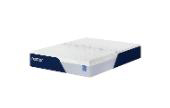
at Nectar
- Our thoughts: We love the cooling aspects of this mattress
- What it does: Our tester enjoyed the motion isolation capabilities; it almost entirely reduces movement transference
- Who it’s for: Great for hot sleepers and couples
- What makes it different: It includes up to six inches of memory foam for enhanced pressure relief and extra cushioning
Pros
- 365-night sleep trial
- Returns to baseline temperature quickly
- All foam layers are CertiPUR-US® certified
Cons
- Limited bounce can make it harder to move or stand
- On the firmer side
- Not the best for side sleepers
Our Thoughts on the Nectar Classic Memory Foam
The Nectar Classic Memory Foam mattress has four different layers of foam for pressure relief, motion control, responsive lumbar support, and cooling—a must-have if you’re sleeping next to another person. We also love that it costs less than $700, potentially saving you hundreds of dollars compared to other memory foam mattresses! Plus, this model was among the best hotel mattresses our team tested.
Our team was impressed by this model’s cooling abilities. This mattress returned to its baseline temperature in only about 3 minutes and 15 seconds after our tester Courtney, a 29-year-old combination sleeper in the average weight category (130 pounds to 220 pounds), stood up. This test result earned the Nectar a 5 out of 5 for its cooling features. As its cooling time was faster than other mattresses on our list, we recommend this pick for couples and hot sleepers. The cooling layer of the mattress is made with a poly-blend fabric top cover with cooling polyethylene fibers and is included in the initial cost.
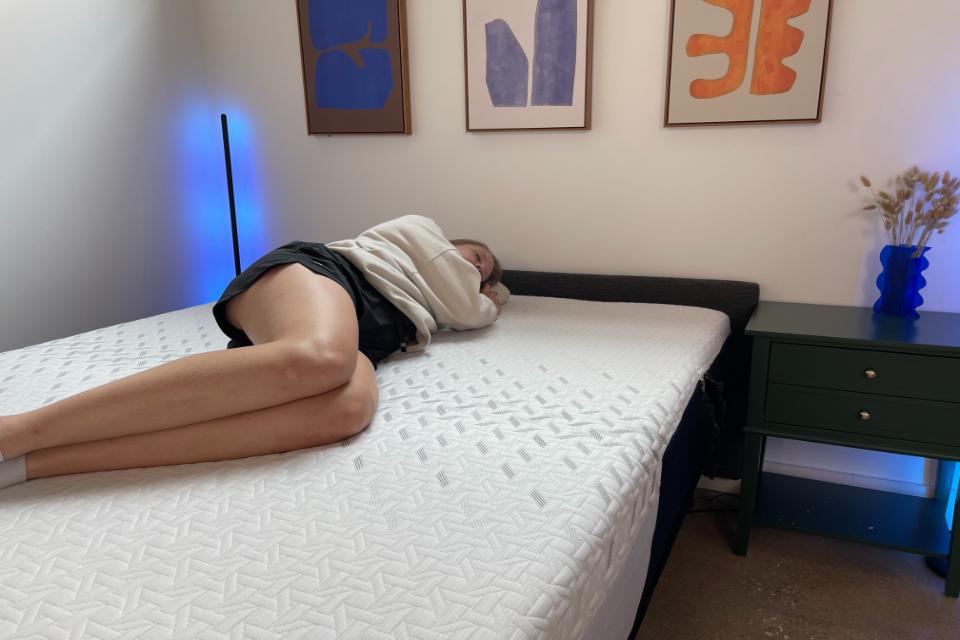
Courtney rated this mattress a 5 out of 5 for both motion isolation test and couple’s sleeping. While undergoing the motion test, Courtney noted that the container of balls on the bed showed no disruption when she sat and laid down on the bed. “The mattress felt solid underneath me, and I did not feel movement transferred throughout,” she said. Even as she rolled onto her back and got off the bed, the balls continued to slowly spin but did not bounce or show any further disruption.
During the couple’s motion test, Courtney barely felt any movement as her testing partner got onto the mattress and adjusted positions. “There was one instance when I felt a slight motion, but it was not very noticeable,” she said. “If I were asleep, I don’t think it would’ve woken me up.” As memory foam models often do, this mattress offers fantastic motion isolation for those seeking to reduce sleep disturbance from a partner.

Courtney also tested the sinkage of the mattress while sitting on the edge. She felt some sinkage, but it was minimal. She felt there was good support, but not a lot of assistance when standing up. She rated the Nectar Classic a 4 out of 5 on edge support—if you’re looking for more support when getting in and out of bed, we recommend the DreamCloud Classic Hybrid, up next.
Generally, memory foam beds are best for side sleepers. Memory foam contours to your body, helping support your shoulders and hips while on your side. That said, this one can also work for back sleepers who prefer a firm mattress.
Specs
- Trial Period: 365 nights
- Materials: Pressure-relieving memory foam, responsive support foam, foundational foam, shift-resistant cover
- Firmness Level: 9/10
- Price for Queen: $1,548
Best Mattress for Side Sleepers Under $1,000: DreamCloud Classic Hybrid
DreamCloud Classic Hybrid
| Fortune score | 4/5 |

at DreamCloud
- Our thoughts: This mattress’s responsive support includes memory foam for pressure relief, innerspring coils for edge support, and body-cradling comfort
- What it does: Offers superior temperature control
- Who it’s for: Side sleepers
- What makes it different: This hybrid mattress provides excellent value and includes $600 worth of sleep accessories such as cooling pillows
Pros
- Included cooling CloudQuilt™
- 365-night sleep trial
- Lifetime warranty
Cons
- Potentially too firm for folks under 130 pounds
- Motion isolation could be better
- No firmness options
Our Thoughts on the DreamCloud Classic Hybrid
For those who want a quality hybrid mattress without a high price tag, the DreamCloud Classic Hybrid includes a breathable cashmere-blend quilted cover and gel-infused memory foam layer to help relieve hip and shoulder pressure, optimal features for side sleepers.
Our tester Courtney is a 29-year-old combination sleeper, meaning she alternates stomach and side sleeping, of average weight (130 pounds to 220 pounds for our purposes). Courtney felt this mattress curve to the side of her body nicely, particularly in her hips and shoulders. “My spine feels pleasant and there is no discomfort in my shoulder or neck.” She rated the DreamCloud Classic a 5 out of 5 for pressure relief on her side. Given how well this bed supports your neck and shoulders, it may be a suitable pick for side sleepers. However, generally, hybrids are dynamic and can work for most sleep positions.
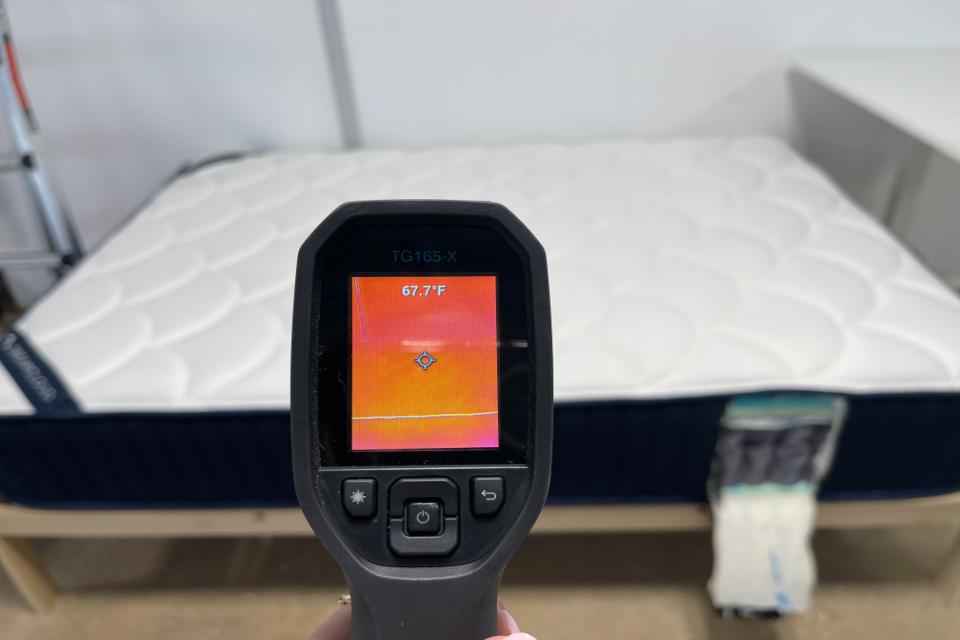
For the motion isolation test, which involves monitoring the movement of a container of bouncy balls on the bed, Courtney gave this mattress a 4 out of 5. “As I initially got on the mattress and laid down, there was some movement of the balls, but more of a wave rather than a jolt. As I shifted around, the balls continued to slowly shift but were not disturbed again when I rolled onto my back or got off the mattress.”
Our team also tested this bed with a second person, monitoring how much movement Courtney noticed as they got in and out of bed. She gave this couple’s motion test a 3.5 out of 5. Courtney said she “barely noticed when the partner first got on the mattress.” She added, “As the partner adjusted their positions, I felt the movement of the mattress throughout.” For those who want superior motion isolation, we recommend the Nectar Classic Memory Foam, which may be better for couples.

If you’re a warm sleeper, this budget-friendly model is a good choice. “This mattress remained a comfortable temperature,” Courtney said, adding that it “did not feel warm to the touch after I got up.” It took approximately 4 minutes and 15 seconds to return to its baseline temperature after Courtney got out of bed, scoring a 4 out of 5 on the cooling gun test.
It’s worth noting that if you purchase the DreamCloud Classic, you’ll also get some accessories, such as a mattress protector, sheet set, and two cooling pillows—a deal you can’t even get with some of the best luxury mattresses.
Specs
- Trial Period: 365 nights
- Materials: CloudQuilt top, contouring memory foam, responsive foam, individually wrapped coils, dense foam, protective bottom cover
- Firmness Level: 8/10
- Price for Queen: $1,719
Best Hybrid Mattress Under $1,000: Brooklyn Bedding Signature
Brooklyn Bedding Signature Hybrid
| Fortune score | 4/5 |
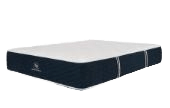
at Brooklyn Bedding
- Our thoughts: Our tester enjoyed the edge support
- What it does: This bed offers luxury mattress quality at a factory direct price
- Who it’s for: Ideal for average and higher weight folks, back sleepers
- What makes it different: Contains hyper-elastic foam and over 700 individually wrapped coils for contouring support
Pros
- 120-night sleep trial
- Cheaper than other hybrids we tried
- Good edge support
Cons
- May not provide enough motion isolation for couples
- Potentially too hot for warm sleepers
- Cloud pillow top costs extra
Our Thoughts on the Brooklyn Bedding Signature
The Brooklyn Bedding Signature Hybrid is our favorite affordable hybrid-in-a-box, combining supreme response comfort foam and variflex transition foam with 8-inch individually cased coils. It ships free and comes with a 120-night sleep trial. Our tester, Kate, a 25-year-old lightweight (meaning 130 pounds or less) side sleeper, loved this bed’s motion isolation and edge support.
This mattress scored a 4 out of 5 on the motion test. There was only slight movement by the bouncy balls when Kate got in and out of bed. She noticed, “They settled quickly and hardly moved when I would roll slightly towards the container.” Kate only noticed the balls wiggle when she would more aggressively change positions, such as slamming her hips when turning on her side.
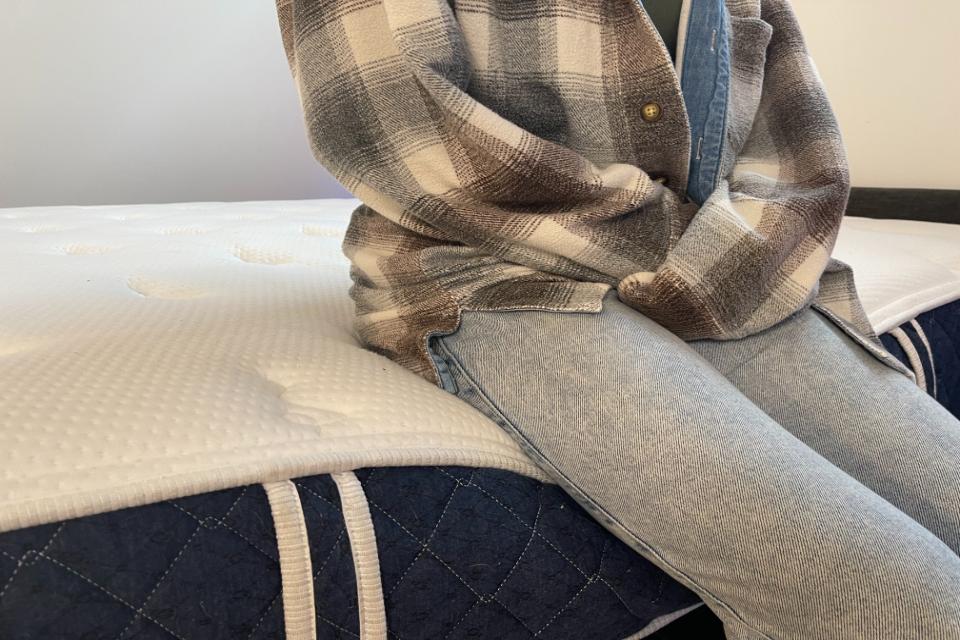
Kate couldn’t feel her co-tester getting in and out of the bed but could feel movement when they were in bed. After the original motion test’s high score, she was surprised by these results, giving the Signature Hybrid a 3 out of 5 on the couple’s motion test. So, if your partner tends to move around a lot in their sleep, this may not be the most ideal pick. Instead, we’d suggest opting for the Nectar Classic Memory Foam mattress.
However, this bed had amazing edge support. Kate gave the Signature Hybrid a 5 out of 5 for edge support, feeling that the mattress was comfortable even on the edges, and that it assisted her as she stood up. “I didn’t feel like I was being spring out towards the wall, but the edge gave enough lift around my thighs that it was easy to get up,” she said.
When Kate was on her side, she felt like she could lie there all night and not fall off. “It was soft enough with enough support right on the edge that it was honestly pretty comfortable,” she said, rating this bed a 5 out of 5 for side support. Alongside side sleepers, stomach sleepers may enjoy this bed, as it earned a 4 out of 5 for pressure relief while stomach sleeping.
While lying on her back, Kate’s head and shoulders felt more elevated than her hips. “I think this would be great for an average weight back sleeper, but for someone who is light weight and needs more sinkage in the shoulder area, it’s not for them.” We recommend this mattress for folks of average or of higher weight, who may find firmer support to fit their needs.
Specs
- Trial Period: 120 nights
- Materials: Quilted top, 1.5″ supreme response comfort foam, 1″ variflex transition foam, 8″ individually encased coils, .25″ flex base
- Firmness Level: 3-7/10
- Price for Queen: $1,332
Best Memory Foam Mattress Under $1,000: Bear Original
Bear Original
| Fortune score | 4/5 |
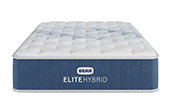
at Bear
- Our thoughts: With three types of foam layers, this mattress is great for folks who weigh more and are looking for added firmness
- What it does: Offers superior motion isolation and support
- Who it’s for: Couples, combination sleepers
- What makes it different: This mattress includes a unique graphite gel-infused memory foam comfort layer for pressure point relief and cooling
Pros
- 120-night sleep trial
- GreenGuard Gold Certified
- Fiberglass-free, making it less flammable
Cons
- May be too firm for folks under 130 pounds
- Celliant-infused cooling cover costs extra
- Edge support is weak
Our Thoughts on the Bear Original
The Bear Original is our pick for the best memory foam mattress under $1,000. Made with CertiPUR-US® certified foams, its all-foam design limits movement, making it great for folks who co-sleep with a partner or pets.
Our tester for the Bear Original is Kate, who is 25, lightweight (under 130 pounds for our purposes), and a side sleeper. Kate scored it a 5 out of 5 for both solo motion isolation as well as couple’s motion. She says, “I couldn’t feel any movements when my testing partner was getting in or out, or when she was moving around, adjusting in the bed.” She also noted that during her solo test, the bouncy balls were hardly disturbed, they only slightly moved when she changed positions. The balls settled quickly, barely moving. That being said, we think this mattress is a great choice for both its value and ability to reduce motion.
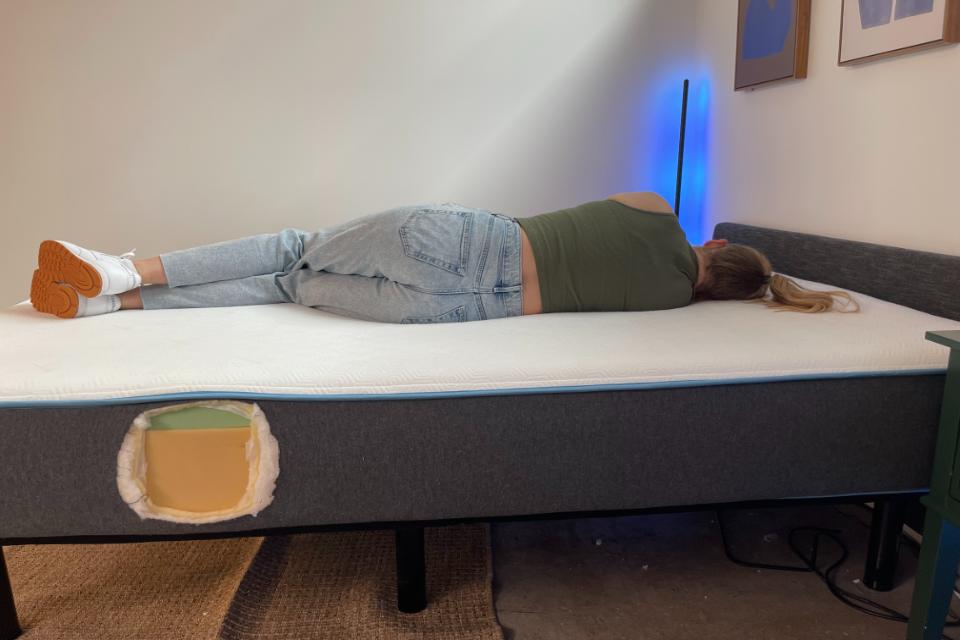
This is among the firmest mattresses Kate tested. Due to her lighter weight, she felt some pressure while lying on her back, saying, “On this mattress, I cannot sink down at all, which leaves my shoulders and hips at a very awkward angle.” We recommend this mattress for folks of a higher weight who may prefer a more supportive sleep experience.
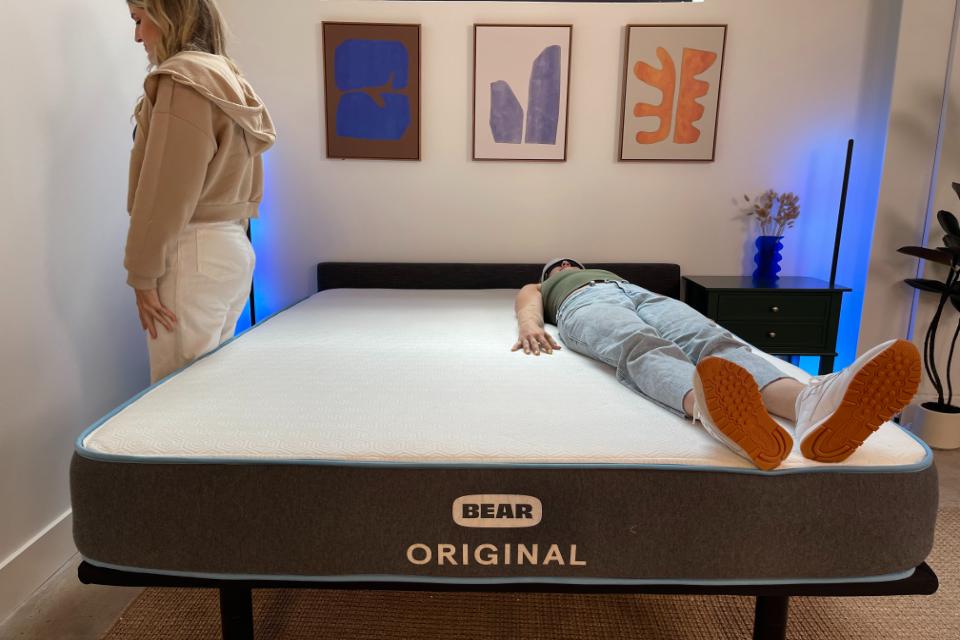
Kate enjoyed the cooling capabilities of the Bear Original, saying, “It didn’t noticeably heat up by any means, and the fabric didn’t feel too warm.” She felt that this mattress would be one to stay pretty cool throughout the night. The mattress’s baseline temperature was recorded as 68.8 degrees and warmed up to 78.6 degrees after Kate tested it, earning it an average score of 3.5 on our cooling test. If you’re looking for a mattress with more cooling features, we recommend the Nectar Classic Memory Foam.
Specs
- Trial Period: 120 nights
- Materials: Quilted cover, cooling gel memory foam, Bear dynamic foam, high-density support foam
- Firmness Level: 6.5-7/10
- Price for Queen: $998
Other Mattresses We Tested
We tested more than thirty mattresses hands-on in our lab. Here are a few that we considered but didn’t make our list of top picks, and why.
- The DLX Classic mattress didn’t provide enough pressure relief to our tester while on her side. She felt that her spine was not aligned, and could also feel pressure building in her neck, so it did not make our list.
- DreamCloud’s Premier Memory Foam mattress offered very little support around the perimeter, with our tester noting that she could easily slide off of it, rating it a 3 out of 5 for edge support.
- Our tester found Brooklyn Bedding’s Aurora Luxe Cooling mattress to be firmer than described, making it more of a firm bed than medium firm, which may not be desirable for side sleepers or those of a lighter weight.
How We Tested and Selected the Best Mattresses Under $1,000
We tested and evaluated over 30 mattresses on a score of 1-5 for factors such as pressure relief, motion control, cooling aspects, firmness, bounce, edge support, and value. Our testers evaluate the products based on their own individual experiences and preferences. We then review their testing feedback and data to share our findings and recommendations with you.
Pressure Relief
When evaluating pressure relief, we first look at a mattress’s construction, materials, and firmness level. We then use a pressure map, which displays where pressure builds on a tester’s body by using heat-mapping technology during their evaluation.
Not only do we gather this objective data, but the tester also provides their own description of where they might feel pressure when trying out the mattress.
Cooling
When evaluating the temperature control of a mattress, we utilize a thermal gun to record the temperature of the mattress before and after the tester lies on it for two minutes. We then measure how long it takes the mattress to return to baseline temperature, giving as an objective cooling test.

Our testers also provide feedback on how warm or cool they feel, so we compile both objective and subjective data.
Motion Isolation
When examining a mattress’s motion isolation capabilities, we run both a motion test and a couple’s motion test. The motion test involves measuring the movement of balls in a container at one end of the bed as the tester completes several movements.
For the couple’s motion test, one tester wears noise-cancelling headphones and a blindfold, while the other tester completes a series of movements. The blindfolded tester then reports any motions they felt throughout the experiment.
Bounce
When testing for bounce, we drop a medicine ball from a 6-foot height onto each mattress. We then measure how high the ball bounces into the air after hitting the mattress. If the ball bounces less than 5.99 inches, the mattress is considered to have an extremely low bounce. If the ball bounces over 15 inches, it’s considered to have an extremely high bounce. Between 9 and 12 inches of bounce is an average amount of bounce.
We test the bounce to measure a mattress’s responsiveness, meaning how quickly it returns to its original shape after you’ve moved around. This helps you to change positions while sleeping more easily and avoid feeling stuck.
Edge Support
During our edge support test, we place 130–150 pounds of weight plates on the mattress edge to measure how much it sinks, simulating a real person’s weight. If our tape measure shows that a mattress sinks 7.9 inches or more during this test, we give it a 1-star rating. If the mattress sinks less than or equal to 3 inches, it earns a 5 out of 5.
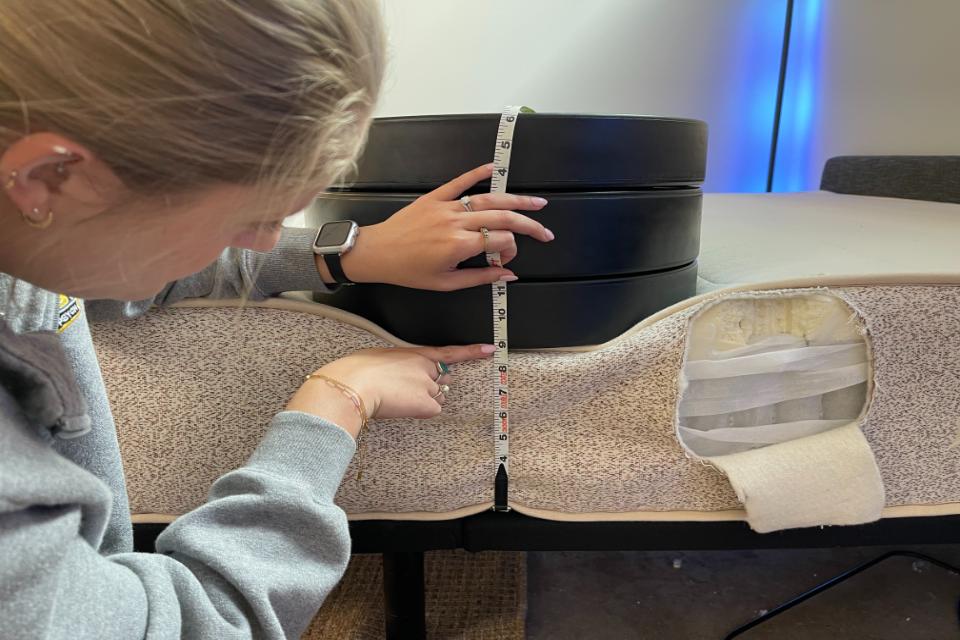
Finally, our mattress testers also sit on the edge of the mattress and provide a subjective rating out of 5 on how supported they feel. A more supportive mattress edge can feel more comfortable for those who may need a little more help getting in and out of bed or for folks who take up more space on the surface.
Durability & Materials
When choosing which mattresses to feature, we also consider materials such as hybrid, latex, and memory foam. This may help you choose the type of mattress that’s best for your individualized sleep needs. We also consider materials that are eco-conscious and have special certifications.
Value
When considering value, we review mattress materials and construction by cutting each one open. We also place a higher value on brands that manufacture their mattresses in America and use environmentally conscious materials. Below, we compare our different picks, taking a look at their features and costs side-by-side.
| Mattress | Sizes | Height | Comfort level | Cost |
|---|---|---|---|---|
| Nectar Classic Memory Foam | Twin, Twin XL, Full, Queen, King, CA King, Split King | 12 inches | Medium firm | $649 |
| DreamCloud Classic Hybrid | Twin, Twin XL, Full Queen, King CA King, Split King | 12 inches | Firm | $649 |
| Brooklyn Bedding Signature | Twin, Twin XL, Full, Short Full, Queen, Short Queen, King, Short King, Olympic Queen, CA King, Split CA King, RV King | 12.25 inches | Soft, medium, firm | $932.40 |
| Bear Original | Twin, Twin XL, Full, Queen, King, CA King, Split King | 10 inches | Firm | $556 |
| Nectar Classic Memory Foam | |
|---|---|
| Sizes | Twin, Twin XL, Full, Queen, King, CA King, Split King |
| Height | 12 inches |
| Comfort level | Medium firm |
| Cost | $649 |
| DreamCloud Classic Hybrid | |
| Sizes | Twin, Twin XL, Full Queen, King CA King, Split King |
| Height | 12 inches |
| Comfort level | Firm |
| Cost | $649 |
| Brooklyn Bedding Signature | |
| Sizes | Twin, Twin XL, Full, Short Full, Queen, Short Queen, King, Short King, Olympic Queen, CA King, Split CA King, RV King |
| Height | 12.25 inches |
| Comfort level | Soft, medium, firm |
| Cost | $932.40 |
| Bear Original | |
| Sizes | Twin, Twin XL, Full, Queen, King, CA King, Split King |
| Height | 10 inches |
| Comfort level | Firm |
| Cost | $556 |
How to Find the Best Mattresses Under $1,000
Everyone has different mattress needs depending on body type, ideal sleep position, and pre-existing health conditions. Your sleep quality is directly tied to your work performance, quality of life, and ability to think clearly. The right mattress for you is also a great productivity tool, if you think about it!
Here’s what to consider when selecting the best mattress under $1000 for you.
Value
When it comes to buying a mattress, we understand that folks have different preferences and considerations for their budget. There are multiple factors that play a part in what you feel comfortable spending.
A good mattress allows you to mentally reset overnight and prepares you to be productive and alert during your demanding and busy workday. Ultimately, selecting a quality mattress will enhance your life, helping you to be at the top of your game, which is a great return on your investment.
Many hotel mattress brands offer sleep trials, ranging from 100 to 365 nights. Some also offer free returns.
Sleep Position
Folks tend to vary in the way that they sleep: on their side, back, stomach, or a combination of different positions. Here are mattress types that may work best for each:
- Side sleepers: We recommend a medium soft to medium firm mattress for support and alignment while on your side. Typically, memory foam or hybrid options may work for pressure relief.
- Back sleepers: We suggest a medium firm mattress to help raise your hips to an even level while on your back. As far as type of mattress, a memory foam, latex, or hybrid mattress is recommended for equal support.
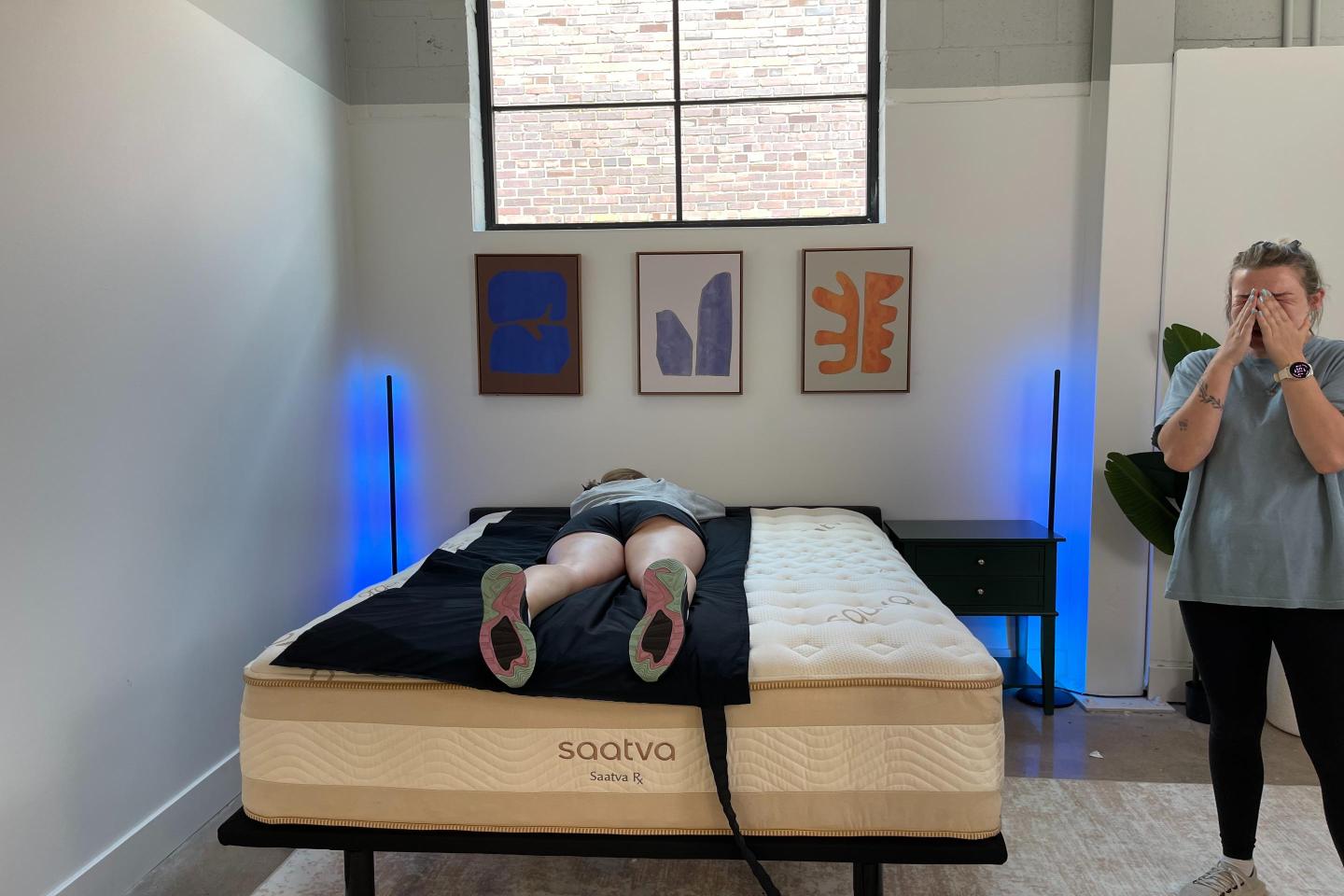
- Stomach sleepers: We advise trying a medium firm or firm mattress to support and keep your hips level while on your stomach. Usually, an innerspring or a firm hybrid mattress will work well for core stability.
- Combination sleepers: We recommend a medium firm mattress for versatility, ensuring that you’re comfortable no matter what position happen to lay in. A latex or responsive hybrid mattress may work best for you for ease of movement as you shift around.
Weight and Height
When buying a mattress, consider how your height and weight, as well as that of your sleeping partner, may impact which mattress suits you best. For instance, folks over 6’2” may need a longer mattress to prevent their feet from hanging over the end of the bed. In this case, a California King mattress or a Twin XL may be preferred. Lightweight sleepers under 130 pounds may need a more plush and contouring type of mattress so that they can feel proper pressure relief, rather than a very firm mattress.
Mattress Material and Mattress Type
Mattresses are frequently made with different types of material and varying layers. These materials may feel different to you and have multiple degrees of comfort depending on your personal preferences. Here are highlights and possible drawbacks to the most popular mattress materials:
- Memory foam: Mattresses made of this material are usually great for pressure relief and motion reduction. Potential drawbacks of memory foam include possible trapping of heat, and the mattress may be less responsive overall.
- Natural latex: Mattresses made with natural latex are typically more eco-friendly than other materials and are more breathable. Possible pitfalls are that this material may make a mattress too firm for some folks, and it may be more difficult to move due to weighing more.
- Innerspring: Mattresses made with this material are bouncier than mattresses made with other materials. Innerspring also helps to promote good airflow – great if you tend to sleep hot. Potential drawbacks of this type of mattress are that it may be noisy, and may be less durable over time, wearing down faster than other materials.
- Hybrid (combines foam and coils): Highlights of this type of mattress are that the combination of materials usually helps with comfort and feeling balanced. Hybrid mattresses may be heavier, and potentially more expensive than mattresses made with other materials.
For most folks, an overly soft or overly firm mattress isn’t ideal, according to Andrea Matsumura, MD, MS, FACP, FAASM. “Avoid overly soft mattresses that can allow the spine to sink out of alignment, as well as overly firm mattresses that don’t offer enough contouring with your body,” she says.
Instead, Dr. Matsumura recommends looking for a medium-firm bed. Look for one that contours to your body without allowing your hips to sag. “This helps maintain the natural curve of your spine and reduces strain on pressure points like the hips and shoulders,” she says. “Memory foam and hybrid mattresses are often good options because they combine overall support with pressure relief in the right areas.”
Cooling Abilities
Many mattresses have cooling features that are included in the materials or can be added on as an upgrade. Consider mattresses with a breathable, organic cotton cover or top, which helps to circulate air around your body. Materials such as gel-infused memory foam, GlacioTex™ cooling fibers, and more can help to keep your bed temperature-controlled throughout the night so you don’t get too hot.
Prior Aches and Pains
A high-quality hybrid mattress is generally good for pressure relief, however, go with what makes you feel more comfortable and pain-free. If you’ve experienced aches and pains, we recommend speaking with your doctor or other healthcare professional about the best type of mattress for your condition(s).
A professional will be able to review any pre-existing conditions and talk to you about possible chronic pain that you’d like to alleviate, then recommend an ideal mattress type.
Certifications
When selecting an affordable mattress, consider its third-party certifications. These certifications provide independent, non-profit verification that a mattress is made with quality materials and are eco-conscious.
Here are a few certifications that are important to keep in mind:
- Global Organic Textile Standard (aka GOTS): Ensures that organic textiles are sourced in a socially and environmentally conscious way
Global Organic Latex Standard (aka GOLS): Ensures that the organic latex utilized is sourced in an environmentally responsible way - CertiPUR-US ®: Certifies the safety of foam and its emissions
- GREENGUARD Gold: Certifies that the materials emit a low level of chemicals, making the products suitable for safe use indoors
Frequently asked questions
Should I buy a mattress under $1,000?
We recommend buying a mattress that works well for your budget and financial situation. There are plenty of quality mattresses that cost under $1,000 and have great value.
What is the best mattress under $1,000?
Our pick for the best mattress under $1,000 is the Nectar Classic, as it costs under $700, potentially saving you hundreds of dollars compared to other memory foam mattresses! Our team loved the cooling capabilities of the Nectar Classic.
How often should you replace your mattress?
You should aim to replace your mattress every 8 to 10 years, depending on the type of materials it is made of. For example, an innerspring mattress may need to be replaced sooner, between 5 and 7 years, while a hybrid mattress may last for 7 to 10 years.
Can I find a king mattress under $1,000?
Yes, you can certainly find a king-size mattress for under $1,000. Check out our picks for the best king mattress, and be sure to watch for seasonal sales and discounts.
